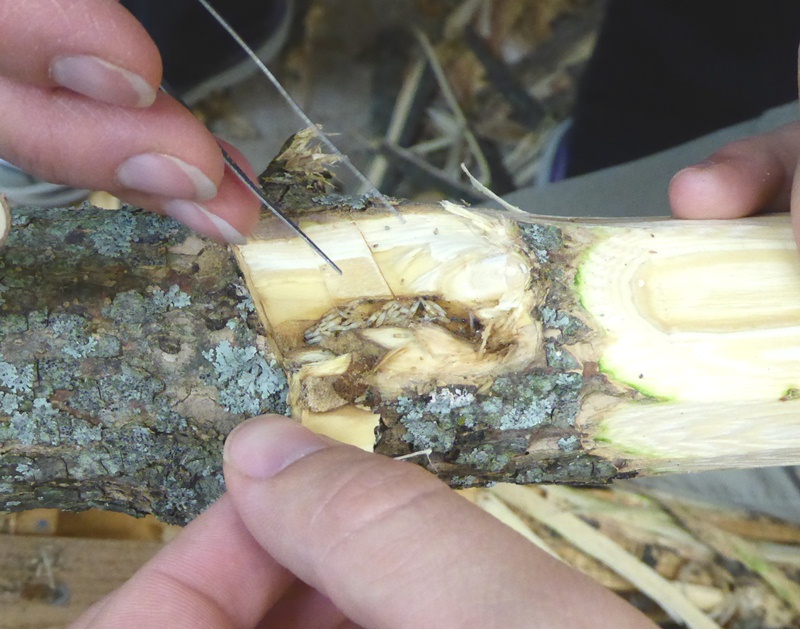Not all sites fit the criteria for biological control. Once an EAB infestation is identified, several steps need to be completed to determine if biological control is viable:
- Perform a delimit survey of the infestation to identify the perimeter of where symptoms are visible.
- Gauge the intensity or pest pressure in the area based on severity of EAB symptoms throughout the identified visibly infested area. Low to moderate EAB densities are recommended for potential sites.
- Identify forested areas on public or private land within the visibly infested area where removal and/or treatment of infested ash trees will not be feasible. Size and composition of forest should be at least 40 acres and at a minimum include 20 percent ash of varying size class. Ideally, the site would be greater than 25 percent ash and connected to other woodlots.
Not all sites fit the criteria for biological control. Once an EAB infestation is identified, several steps need to be completed to determine if biological control is viable:
- Perform a delimit survey of the infestation to identify the perimeter of where symptoms are visible.
- Gauge the intensity or pest pressure in the area based on severity of EAB symptoms throughout the identified visibly infested area. Low to moderate EAB densities are recommended for potential sites.
- Identify forested areas on public or private land within the visibly infested area where removal and/or treatment of infested ash trees will not be feasible. Size and composition of forest should be at least 40 acres and at a minimum include 20 percent ash of varying size class. Ideally, the site would be greater than 25 percent ash and connected to other woodlots.
Not all sites fit the criteria for biological control. Once an EAB infestation is identified, several steps need to be completed to determine if biological control is viable:
- Perform a delimit survey of the infestation to identify the perimeter of where symptoms are visible.
- Gauge the intensity or pest pressure in the area based on severity of EAB symptoms throughout the identified visibly infested area. Low to moderate EAB densities are recommended for potential sites.
- Identify forested areas on public or private land within the visibly infested area where removal and/or treatment of infested ash trees will not be feasible. Size and composition of forest should be at least 40 acres and at a minimum include 20 percent ash of varying size class. Ideally, the site would be greater than 25 percent ash and connected to other woodlots.
After a viable biological control site is identified, coordination by the MDA with local natural resource managers, property owners and the USDA EAB Parasitoid Rearing Facility are necessary. At each site one must obtain permission, guarantee access and ensure other management objectives won’t interfere with implementation. Special permits may be necessary depending on the ownership and designation of land. Long term site access is important for follow-up monitoring of ash health and documenting parasitoid establishment.
EAB Biological Control Agents Recovered
- Tetrastichus planipennisi has been recovered at multiple locations in southeastern Minnesota, Twin Cities metro, and Duluth. These finds show that T. planipennisi can survive an extremely cold winter and are establishing and reproducing. These wasps were found by debarking branches and logs and examining them for wasps, dissecting EAB larva and deploying yellow pan traps.
- Spathius galinae has been recovered from sites in Duluth, Minneapolis, and southeastern Minnesota. These finds show that S. galinae can overwinter and are establishing and reproducing. These wasps were found by deploying yellow pan traps and debarking branches and logs and examining them for wasps.
- Oobius agrili has been recovered from multiple locations in southeastern Minnesota, Twin Cities Metro area, and Duluth. EAB eggs were collected from bark samples then examined for evidence of parasitism and adults were recovered by deploying yellow pan traps. This detailed presentation showing how to look for Oobius agrili (PDF: 2.89 MB / 52 pages)
Parasitoid Recovery Methods
This method of parasitoid recovery is the most labor intensive and requires the felling of branches or entire trees. Bark is removed in thin layers down to the cambium where EAB larval galleries and intact larvae are documented, collected and examined for evidence of parasitism.
Branches are peeled then examined

Immature Tetrastichus planipennisi in an EAB gallery
This method of parasitoid recovery is the most labor intensive and requires the felling of branches or entire trees. Bark is removed in thin layers down to the cambium where EAB larval galleries and intact larvae are documented, collected and examined for evidence of parasitism.
Branches are peeled then examined

Immature Tetrastichus planipennisi in an EAB gallery
This method of parasitoid recovery is the most labor intensive and requires the felling of branches or entire trees. Bark is removed in thin layers down to the cambium where EAB larval galleries and intact larvae are documented, collected and examined for evidence of parasitism.
Branches are peeled then examined

Immature Tetrastichus planipennisi in an EAB gallery
A method used in conjunction with tree debarking. All intact EAB larvae with no outward signs of parasitism are collected during the process. Larvae are then dissected under a microscope to look for internal immature wasp larvae. The rear end of the insect is removed with a surgical scissors and the innards are pushed out into droplets of water. If the EAB larva is parasitized, the wasp larva(e) will float to the surface.
A method used in conjunction with tree debarking. All intact EAB larvae with no outward signs of parasitism are collected during the process. Larvae are then dissected under a microscope to look for internal immature wasp larvae. The rear end of the insect is removed with a surgical scissors and the innards are pushed out into droplets of water. If the EAB larva is parasitized, the wasp larva(e) will float to the surface.

